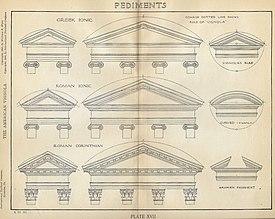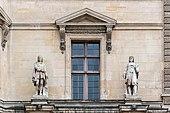A pediment is an architectural element found particularly in Classical, Neoclassical and Baroque architecture, and its derivatives, consisting of a gable, usually of a triangular shape, placed above the horizontal structure of the lintel, or entablature, if supported by columns. The tympanum, the triangular area within the pediment, is often decorated with relief sculpture. A pediment is sometimes the top element of a portico. For symmetric designs, it provides a centre point and is often used to add grandness to entrances.[1]
History
The pediment is found in classical Greek temples, Etruscan, Roman, Renaissance, Baroque, Rococo, Neoclassical and Beaux-Arts architecture. A prominent example is the Parthenon, where it contains a tympanum decorated with figures in relief sculpture. This architectural element was developed in the architecture of ancient Greece and first appeared as gable ends of Greek temples. In ancient Rome, the Renaissance, and later architectural revivals, the pediment was used as a non-structural element over windows, doors and aediculae. Some used to protect windows and openings from weather.[2] As classical architecture moved to Britain during the Renaissance, pediments wouldn't fit with the steeply pitched roofs and became detached from the structure to only create an impression.[3] The form of the pediment is dictated by the primary function of the roof which in several areas is the dismissal of rainwater.[2]
A variant is the "segmental" or "arch" pediment, where the normal angular slopes of the cornice are replaced by one in the form of a segment of a circle, in the manner of a depressed arch. Both traditional and segmental pediments have "broken" and "open" forms. In the broken pediment the raking cornice is left open at the apex. The open pediment is open along the base – often " sculpture, "tondo" paintings, mirrors or windows. These forms were adopted in Mannerist architecture, and applied to furniture designed by Thomas Chippendale. The terms "open pediment" and "broken pediment" are often used interchangeably.[4] Another variant is the swan's neck pediment and is a refinement of a broken pediment with two "S"-shaped profiles resembling a swan's neck. Non-triangular variations of pediments are usually found over doors, windows, and porches.[5]
Gallery
One of the few sections of the sculpture of the pediment of the Parthenon still in place; others are the Elgin marbles in the British Museum (London)
Illustrations with the sculptures of the two pediments of the Parthenon, by James Stuart & Nicholas Revett in 1794
Segmental pediment of the Library of Celsus (Ephesus, Turkey)
Pediment with sculptures at an entrance of the National Museum of Romanian History (Bucharest)
Door with a broken and open pediment, with a cartouche in it
Pediment with a coat of arms in it, above a door from Leeuwarden (the Netherlands)
Pediment of the Théâtre de la reine, part of the Petit Trianon (France)
See also
- Classical architecture
- Gable
- Pedimental sculptures in the United States
- Temple (Greek)
- Temple (Roman)
Notes
- ^ Partridge, Chris (March 6, 2005). "Cash: Property: KNOW YOUR PEDIMENTS: A weekly guide to the language of architecture". Gale OneFile: News. Retrieved December 3, 2019.
- ^ a b Waterhouse, Paul (Oct 29, 1886). "PEDIMENTS AND GABLES.-I". ProQuest 6850264.
- ^ Partridge, Chris (March 6, 2005). "Cash: Property: KNOW YOUR PEDIMENTS: A weekly guide to the language of architecture". Gale OneFile: News. Retrieved December 3, 2019.
- ^ Harris, Cyril M., ed. Illustrated Dictionary of Historic Architecture, Dover Publications, New York, c. 1977, 1983 edition p. 386
- ^ Scott, Gregory J. (April 14, 2016). "'P' Is For 'Pediment'". ProQuest 1781212675.
- ^ Jones, Denna (2014). Architecture The Whole History. Thames & Hudson. p. 277. ISBN 978-0-500-29148-1.
References
- Dictionary of Ornament by Philippa Lewis & Gillian Darley (1986) NY: Pantheon
External links
- Chisholm, Hugh, ed. (1911). . Encyclopædia Britannica (11th ed.). Cambridge University Press.



.jpg)


.jpg)
.jpg)
.jpg)
._There_is_written_MDCCCXCVI_(1896).jpg)
.jpg)




.jpg)
